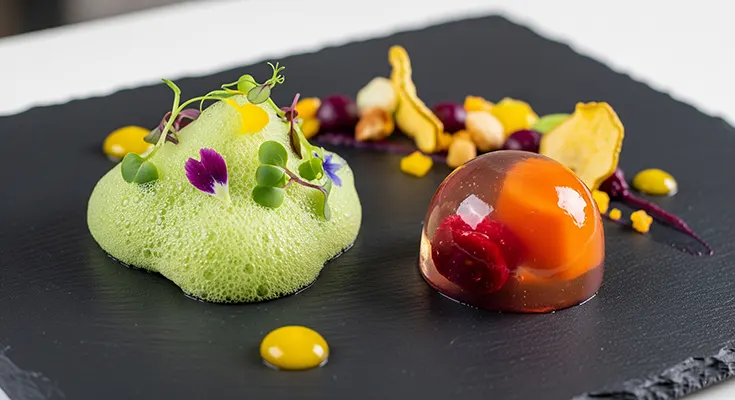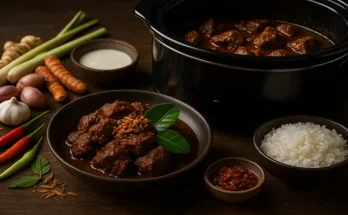Molecular gastronomy, a discipline that explores the physics and chemistry of cooking, has long been associated with avant-garde cuisine and elaborate presentations. While often linked to high-end, meat-centric dishes, its principles and techniques are proving to be invaluable in the burgeoning world of plant-based culinary innovation. Specifically, molecular gastronomy offers a scientific toolkit for creating a diverse array of plant-based foams and gels, adding exciting textures, flavors, and visual appeal to vegan and vegetarian dishes.
The Appeal of Foams and Gels in Plant-Based Cuisine
Foams and gels aren’t just about aesthetics; they offer significant culinary advantages.
- Texture Contrast: They introduce lightness, airiness, and sometimes a satisfying chew or melt-in-the-mouth sensation that can elevate the humble vegetable.
- Flavor Delivery: Foams, in particular, are excellent carriers of aroma, as the air bubbles burst on the palate, releasing concentrated flavor. Gels can encapsulate and deliver bursts of flavor.
- Visual Interest: They transform the presentation of plant-based dishes, making them more dynamic and visually intriguing.
- Reduced Heaviness: By incorporating air or setting liquids, these techniques can make dishes feel lighter and less dense, which is often desirable in plant-based cooking.
The Science of Plant-Based Foams: Whipping Air into Flavor
Creating stable foams relies on the ability of certain molecules to reduce surface tension and trap air bubbles. In traditional cuisine, egg whites and dairy creams are common foaming agents. Molecular gastronomy, however, provides plant-based alternatives with remarkable efficacy.
- Lecithin: Derived from soybeans or sunflowers, lecithin is a powerful phospholipid emulsifier. Its amphiphilic nature (having both water-attracting and fat-attracting parts) allows it to stabilize oil-in-water emulsions and, crucially, to create light, airy “airs” or “froths.” To make a lecithin foam, a liquid (like vegetable broth, fruit juice, or infused oil) is blended vigorously with a small amount of lecithin using an immersion blender, pulling air into the mixture and creating stable bubbles. These foams are delicate and best served immediately.
- Methylcellulose: This plant-derived cellulose ether has a unique property: it gels when heated and melts when cooled (thermo-reversible gelling, but in reverse to common gelling agents). More importantly for foams, certain grades of methylcellulose (like Methocel A4C or F50) act as excellent foaming agents and stabilizers, particularly for hot foams. When a solution of methylcellulose and a liquid is whipped and heated, it creates a remarkably stable, often stiff foam that can withstand higher temperatures than lecithin foams. This allows for warm savory foams, such as a mushroom consommé foam or a roasted red pepper foam, to accompany main courses.
- Saponins: Found naturally in ingredients like aquafaba (the liquid from canned chickpeas) and soapwort, saponins are glycosides that act as natural surfactants, much like soap. Aquafaba has gained immense popularity as a direct substitute for egg whites, capable of being whipped into stiff peaks for meringues, mousses, and light foams. The saponins, along with starches and proteins in the chickpea brine, are responsible for its remarkable foaming ability.
The Art of Plant-Based Gels: Sculpting with Hydrocolloids
Gels are created by forming a network of polymers that trap liquid, giving it a solid or semi-solid structure. While pectin and starches have long been used in plant-based cooking, molecular gastronomy introduces a wider palette of hydrocolloids for more precise and versatile gelling.
- Agar-Agar: A red algae extract, agar-agar is a powerful gelling agent that sets firmly at room temperature and is thermo-reversible (it can be melted and re-set). It creates a much firmer, less elastic gel than gelatin, making it ideal for firm terrines, clear consommés, or even “caviar” pearls when dropped into cold oil. It requires boiling to fully dissolve and activate.
- Carrageenan: Also derived from red seaweed, carrageenan comes in several forms (kappa, iota, and lambda), each with different gelling properties. Kappa carrageenan forms brittle, firm gels, often used in vegan cheeses. Iota carrageenan produces elastic, softer gels that exhibit thixotropy (they become fluid when stirred and re-gel when left to rest), making them suitable for fluid gels or sauces that thicken on standing.
- Gellan Gum: A microbial polysaccharide, gellan gum is incredibly versatile. High acyl gellan forms opaque, elastic, and soft gels, while low acyl gellan creates firm, brittle, and clear gels. It’s often used for its ability to create “fluid gels” – gels that can be blended into a smooth, pourable liquid that still retains some textural body, perfect for sauces, dressings, or as a base for spheres.
- Sodium Alginate & Calcium Lactate (Spherification): This iconic molecular gastronomy technique allows for the creation of liquid-filled spheres with a thin gel membrane. Sodium alginate (a seaweed derivative) is dissolved in a flavored liquid (e.g., fruit juice, vegetable puree). This mixture is then dropped into a calcium chloride or calcium lactate bath. The calcium ions react with the alginate, forming a gel layer on the exterior while the interior remains liquid. This “reverse spherification” (where the calcium is inside the sphere, rather than in the bath) is particularly useful for creating delicate spheres that burst in the mouth.
By embracing the scientific principles and diverse hydrocolloids offered by molecular gastronomy, plant-based chefs can move beyond conventional textures, unlocking new dimensions of creativity and sensory experience. These techniques not only elevate the culinary appeal of plant-based dishes but also challenge perceptions of what vegan and vegetarian food can be.





